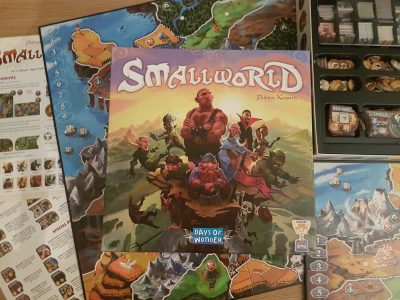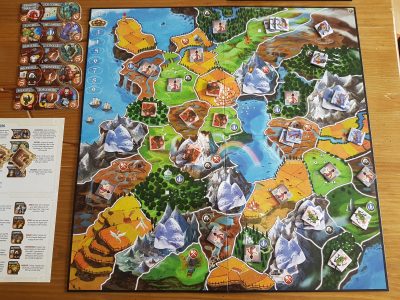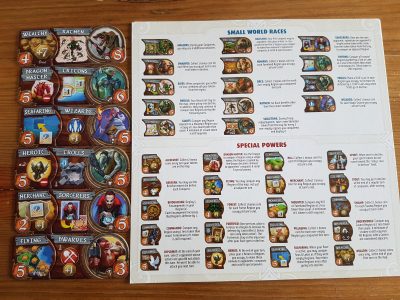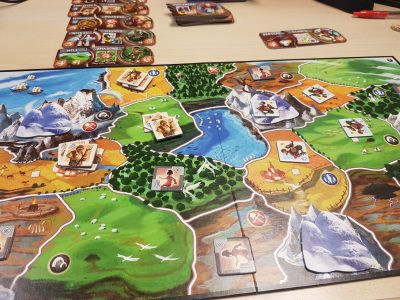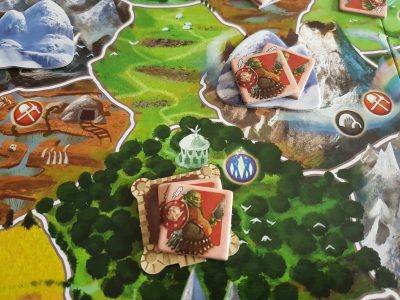Small World is a territory building game with area movement and random combos of races for 2 – 5 players. Designed by Philippe Keyaerts, the game sees players controlling races, such as dwarves, wizards, orcs and boring humans, as they strive to dominate a fantasy world. Empire will come and go throughout a game of Small World all in the quest for gold. However, will Small World be a game to stand the test of time or will it be quick to go into decline? Let’s find out!
Small World has a lot of content in the box which makes it seem like a lengthy ominous rulebook is going to be needed. Thankfully, the rules are short and after only a few rounds everything will have fallen into place. In a standard game the first half of the game will see players initially choose a starting race, spread that race out across the “Small World” and score victory points. Part way through the player will put their race into decline, seeing them controlling a new race again with the aim of taking over the world.
Set up sees the board decided upon by the number of players around the table and 5 Race and Special Power combos randomly put together to create races unique to that game. In turn order players either take the bottom most and 5 Race and Special Power combo or pay gold for each race they skip. The mechanic here Is that gold is the victory points of Small World so it’s more like an investment to get a better race. The only combination I’ve found to date that seemed over powered was Spirit Ghouls allowing players to control more race in decline but due to the probability of this combination coming up the game feels extremely balanced.
Once all players have a race player they get a number of units determined by the figures on the and 5 Race and Special Power parts of their combo. In turn, players enter the Small World via the regions that touch the edge of the board. Unless they have an ability the allows them to fly or arrive by sea. After entering the board by default players can only attempt to invade adjacent regions in an attempt for Small World domination. To claim a region players need to spend two units more than is already there. Unoccupied regions costing 2 units and are the cheapest units-wise to go for. Regions which other players have previously claimed, or regions with neutral villagers on, need to be taken by force. Simply add 2 to the total number of units on the region and that is the number you need to place.
When players have invaded they can then redistribute their units into defensive positions. Controlling regions is the only none ability way of earning gold the valuable commodity that’ll see you become the winner. Therefore, when units are running low and player are unable to invade any additional regions this is about time to jump ship to a new race. There are plenty of abilities that can adjust the rules to some extent. From adding fortresses, which provide additional defence, to Giants who can invade down from a mountain for less units than normal. This is how the races can affect and change up the gameplay from game to game.
When to put your race into decline is a big decision in Small World. It is almost a starting gun, when the first player declares they are putting their race into decline it is often within a round that all other players have jumped to a new race. When doing this, you lose control of the race you were using but they stay on the map and still earn you victory points until removed by either yourself or an opponent. To balance this player can only have one declining race at a time and each region only keeps one unit of the old declined race making them easier to invade. The new race you control is now able to invade the map from any edge region, potentially flanking an opponent.
The trick to the declining mechanic is all about judging when your current race is starting to become overextended: when on turns you have only limited units to invade and control new regions. At the same time if you wait it out not only could you be utilizing the current special powers your race has but that new race you’re hoping to select might get cheaper. It is rare for the 5th and most recently unveiled race to be selected as it would cost 4 victory points to be chosen. Waiting until a couple of other players have taken races allows it to fall down the race ladder making it cheaper to acquire.
The race creation mechanics add in a colossal amount of variation into the game. With a pile of 14 race banners and 20 unique special powers, the amount of possible combinations is insane. Unless playing with the full player limit of 5 chances are only half of the races will enter play resulting in multiple games where specific races aren’t even seen. Thus, the replayability sky rockets as the key battlegrounds of the game are tweaked and changed by simply having different race ability combinations.
One issue that players may have with Small World is a direct result of these combinations and that is returning to the rulebook. Yes, included in the box are player summary sheets so it’s not returning to the actual rulebook more of a cheat sheet. Nevertheless, whenever a player is looking to choose a race they in the first few games have to start scanning the list of races and special powers. Another game which falls at the hurdle of returning to the rulebook is Yamatai but I found this less intrusive in Small World. Thankfully, as it is often only at the offset of the game and only once more when players go into decline it doesn’t disrupt the game’s flow too much.
Four different map game boards are included in the box, with a unique map depending on the number of players. Each seems balanced and keeps the core concepts of the game consistent. The spacing, and number of regions, is just right for number of players. Each map offers the same variety of regions but changes the overall count of regions. The region count is limiting enough to force conflict between players. Players will bump into each other normally just after the second turn. From here the grabbing and battling for regions, the backwards and forwards attacking keeps the player interaction high.
Mechanically a 2-player game is no different. The same style of gameplay is promoted by the changing of the game board. The cutthroat nature certainly ramps up as player numbers decrease. The issue is in a 2-player game, one player will become the winner and one the loser. My personal favourite player count is 4 as the cutthroat nature is replaced by fun and the game length is slightly decreased. In a 4-player game if one player shoots into the lead those trailing behind can always gang up against them and losing seems like of an issue with most players failing alongside you. It just increases the enjoyment when the balance of power is dynamically shifting around the board as those whom jump into the lead are brought back down to Earth, or the Small World, by everyone else.
No two games are alike and that to me is one of the best features of what is an otherwise simple territory building board game. Once you’re past the returning to the rulebook issue the gameplay flows and players will find and determine their own personal favourite race and special power combinations. I was impressed at how the game boards help maintain the balance of the game at differing player counts while maintaining the conflict experience. It takes a good player to snowball into a victory. The majority of the time players will be squabbling and battling for points. This conflict and player interaction style drives the fun factor throughout each and every game. Small World has certainly conquered its way onto my gaming shelf for a long time!
[Editor’s Note: Small World was provided to us by Esdevium Games for review purposes. The game is currently available from 365 Games for £37.99]


